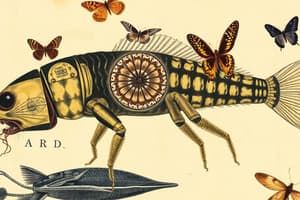Podcast
Questions and Answers
What is a characteristic shared by all mollusks?
What is a characteristic shared by all mollusks?
Strong muscular foot and a feeding structure called a radula.
What is the main characteristic that distinguishes arthropods from other animals?
What is the main characteristic that distinguishes arthropods from other animals?
Jointed appendages and an exoskeleton made of chitin.
What is the significance of the blastopore in deuterostomes?
What is the significance of the blastopore in deuterostomes?
It gives rise to the anus first during embryonic development.
What are the four common characteristics of chordates?
What are the four common characteristics of chordates?
What is the function of epithelial cells in animal tissues?
What is the function of epithelial cells in animal tissues?
What is the difference between skeletal, cardiac, and smooth muscles?
What is the difference between skeletal, cardiac, and smooth muscles?
What is the principle behind negative pressure breathing?
What is the principle behind negative pressure breathing?
What are the three main components of blood?
What are the three main components of blood?
What is the main difference between open and closed circulation systems?
What is the main difference between open and closed circulation systems?
Why are rats often used as model organisms in biology?
Why are rats often used as model organisms in biology?
What is the characteristic of Porifera phylum in terms of symmetry?
What is the characteristic of Porifera phylum in terms of symmetry?
What type of reproduction is common in Cnidaria phylum?
What type of reproduction is common in Cnidaria phylum?
What is the characteristic of Platyhelminthes in terms of internal cavity?
What is the characteristic of Platyhelminthes in terms of internal cavity?
What is the function of gastrovascular cavity in Platyhelminthes?
What is the function of gastrovascular cavity in Platyhelminthes?
What is the characteristic of Nematoda in terms of body covering?
What is the characteristic of Nematoda in terms of body covering?
What is the characteristic of Mollusca in terms of body cavity?
What is the characteristic of Mollusca in terms of body cavity?
What is the function of mantle in Mollusca?
What is the function of mantle in Mollusca?
What is the characteristic of Cnidaria in terms of digestion?
What is the characteristic of Cnidaria in terms of digestion?
What is the characteristic of Platyhelminthes and Nematoda in terms of germ layers?
What is the characteristic of Platyhelminthes and Nematoda in terms of germ layers?
What is the characteristic of Nematoda in terms of digestive tract?
What is the characteristic of Nematoda in terms of digestive tract?
Flashcards are hidden until you start studying
Study Notes
Lab 11: Phyla Porifera and Cnidaria
- Porifera (sponges): simplest of major animal phyla, no tissue, no symmetry, asexual reproduction common, filter feeders
- Cnidaria (sea jellies, coral, hydra, sea anemone): tissues with two germ layers, radial symmetry, asexual reproduction common, two life forms (medusa and polyp), have nematocyst to capture prey, extracellular digestion
Lab 12: Phyla Platyhelminthes and Nematoda
- Platyhelminthes (Flatworms): acoelomate (no internal cavity), tissues with 3 germ layers, bilateral symmetry, gastrovascular cavity with one opening (used as both mouth and anus), free-living and parasitic species with different evolutionary features
- Nematoda (roundworms): pseudocoelomates (have a body cavity), tissues with 3 germ layers, bilateral symmetry, covered with cuticle, complete digestive tract with mouth and anus
Lab 13: Phyla Mollusca and Annelida
- Mollusca: coelomate, protostomes, well-developed organ systems, all mollusks have mantle (specialized layer of epidermal cells that secretes a shell), visceral mass, strong muscular foot, and feeding structure called a radula
- Annelida (earthworms, leeches): coelomate, protostomes, well-developed organ systems, segmented
Lab 14: Phylum Arthropoda
- Arthropoda: most diverse and abundant animals, jointed appendages, exoskeleton (made out of chitin)
- Subgroups: Crustacean (lobsters, crabs, shrimp), Chelicerata (spiders, ticks), Myriapods (centipedes, millipedes), Insects (biggest group of arthropods, have 6 legs and 3 body parts)
Lab 15: Phyla Echinodermata and Chordata
- Echinodermata (Sea stars, sea urchins, sea cucumbers): deuterostomes, radial symmetry, tube feet and water vascular system
- Chordata: deuterostomes, 4 common characteristics (dorsal hollow nerve cord, notochord, pharyngeal slits, post-anal tail)
- Subgroups: Shark (cartilaginous skeleton), Bony fish (swim bladder, lateral line), Amphibian (double life, need water for reproduction), Reptile (amniotic eggs, developed lung, dry skin with scales), Birds (strong flight muscles, hollow bone, endothermic, feathers), Mammals (mammary glands, hair, endothermic)
Lab 16: Animal tissues
- Epithelial: simple squamous cells, cuboidal cells, glandular epithelium cells
- Connective: loose connective tissues, adipose cells, dense connective tissue, blood (red blood cells and white blood cells)
- Muscular: skeletal, cardiac, smooth muscles (differences in functions and appearance)
- Nervous: (not observed in the lab)
Lab 17: Breathing
- Negative pressure breathing: when humans inhale by expanding their lungs, creating a negative pressure that pulls air into the lungs
- Diaphragm: a sheetlike muscle separating the abdomen from the chest cavity, used in breathing
Lab 18: Circulation
- Blood components: red blood cells, white blood cells, platelet, plasma
- Blood vessels: artery, vein, capillary (gas and nutrient exchange occurs here)
- Difference between open vs. closed circulation system
Lab 19-21: Rat anatomy
- Why use a rat as a model organism?
- Anatomy of internal organs: need to know the name of major organs and their functions
- Thoracic cavity: trachea, esophagus, heart, lung, diaphragm
- Abdominal cavity: liver, stomach, small intestine, large intestine, cecum, kidney, uterine horn
Studying That Suits You
Use AI to generate personalized quizzes and flashcards to suit your learning preferences.




